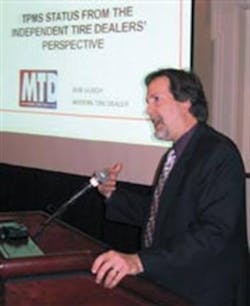Jacques Bajer is an engineer by trade. Percy Ruch is a salesman. Although they have vastly different perspectives, they agree on at least one fundamental rule of retail: The consumer is king.
They did not meet in a bar, as the old joke says, but both attended the third annual Intelligent Tire Technology Conference (ITTC) in Dearborn, Mich., in April. Bajer, president of Tire Systems Engineering Inc. and a longtime contributor to Modern Tire Dealer, helped usher in the radial age of tires in the 1960s. Ruch is national sales manager for Mohawk Rubber Sales of New England Inc., a 75-year-old retail and commercial tire shop supplies distributor based in Hingham, Mass.
The conference focused on the latest tire pressure monitoring system (TPMS) technologies and processes. Bajer has been a participant, sometimes as an observer, in the development of the TPMS for nearly 40 years. That includes the direct and indirect systems.
Ruch and his company handle TPMS scanners from K-Tool Corp., Bartec USA LLC, ATEQ Corp. and OTC, a unit of SPX Corp. They also sell TPMS sensors from Dill Air Controls Products LLC, Pacific Industries and Schrader-Bridgeport International Inc.
[PAGEBREAK]
Ruch also provides TPMS training to tire dealers across the country. “I’ve made it my business to become an expert on these systems, how they work, and how to maintain and service them,” he says.
“After being out in the field, talking to my customers, attending multiple TPMS conferences, and selling these tire pressure monitoring systems, repair kits and the equipment to maintain them, I have grown to better understand the procedural shortcomings.”
During the ITTC’s panel discussion on “Understanding What the OEMs Require,” Ruch voiced his concern about the growing complexity surrounding resetting tire pressure monitoring systems. At last year’s conference, vehicle manufacturers had promised an easier, more user-friendly procedure. “So why has the resetting technology become increasingly complicated, especially for the Japanese and Korean models?” he asked.
Neither Ruch nor Bajer were satisfied with the answers from the panel, which was made up of Dilip Patel, TPMS design engineer from Ford Motor Co.; John Maxgay, lead TPMS engineer for General Motors Corp.; Todd St. John, active chassis controls supervisor for Chrysler LLC; and Hiroshi Ida, chassis design manager for Mitsubishi Motors R&D of America Inc.
“Raising this question created more discussion than I had intended,” says Ruch. “Unfortunately, Jacques and I came away with fewer answers and more conspiracy theories.”
Bajer agrees with Ruch that the engineers skirted the question, providing nothing but “engineering minutia” and leaving the two to talk between themselves.
The TPMS requirement by the TREAD (Transportation Recall Enhancement, Accountability and Documentation) Act “was a premature government mandate,” says Bajer. “It should be fully developed, which it is not. It has to be fully standardized, which it is not.”
“Conference Chairperson Mark Shaw (a senior systems engineer for Freescale Semiconductor Inc.) asked, ‘Why don’t we rescind the whole thing until we get it right?’ I agree.”
[PAGEBREAK]
Mohawk Rubber on the road
Ruch was attending the conference with Mohawk Rubber salesman Wayne Rotella, who also helps train tire dealers on the complexities of tire pressure monitoring systems.
“Some issues we’ve encountered on the road is that due to lack of understanding and confusion, some tire dealerships and technicians have been turning away paying customers and are shying away from offering TPMS services,” says Ruch.
“Another issue is that many consumers may not know the importance of TPMS and optimal tire pressure. Some even dare to ask their tire dealers to disable their systems and warning lights, not realizing the legal ramifications.
“On the plus side, after our training, tire dealers understand the importance and value of TPMS service,” says Ruch, who also credits Tire Industry Association (TIA) training with getting the word out. “By following a system and having the correct tools, equipment and supplies, dealers can easily work with TPMS. They find out it is not as intimidating as it initially seemed.
“They also have the knowledge to educate the end consumer, which ensures support of this important legislation and compliance with tire safety practices by maintaining correct tire pressure. This reduces the risk of on-road accidents and fatalities.”
Despite his concerns, Ruch says the advent of the TPMS has been a good thing for the consumer and the dealer, and he suggests progress has been made in improving the systems.
“There is already a lot of working knowledge and interesting, non-conventional solutions being used.
“If it weren’t for the TIA and individuals like Jacques Bajer, we would never have the satisfaction of watching consumers reach their ‘aha’ moment.”
Given that the government is responsible for the TPMS mandate, and some of its problems, Ruch wonders why it was not represented at the ITTC.
“It is counter-intuitive that the very agency, the National Highway Traffic Safety Administration, required to mandate and uphold the TREAD Act does not have a bigger presence at industry conferences,” says Ruch. “They are crucial in validating and verifying facts, data and statements made by many conference presenters.
“I have some controversial questions for them, too.”
[PAGEBREAK]
Indirect system
NIRA Dynamics AB will launch its indirect tire pressure monitoring system in the United States later this year.
CEO and President Urban Forssell talked about the system, which will be standard on the 2009 Audi A6, at the ITTC. In his presentation, “Recognizing Developments in Advanced Indirect TPMS,” he said the software-based system is designed to pass Federal Motor Vehicle Safety Standard 138, making it the first indirect system to do so. “This is no longer R&D.”
There are no pressure sensors mounted inside the tires. “In this case, the tires are the sensors.”
Initial calibration is required. After that, however, the system is self-learning.
In developing the indirect system, NIRA followed a “test first” approach by designing the tests before the software itself. The system was tested:
* under circumstances which make “nuisance warnings” more likely, and deflation detections more difficult.
* in normal/intermediate conditions “to gain an initial parameter tuning base.”
* in everyday use “under controlled conditions.”
* under extreme external influences.
The NIRA TPMS was tested using different engine and powertrain configurations and tires (including mini-spares) under varying load conditions and driving scenarios.
Forssell said the system is designed to work on mainstream vehicles, regardless of the tire type or size because of its reset and re-learn capabilities.
When asked if the system would accommodate plus-sizing and vehicle customization, Forrsell said yes, in 99.9% of the cases. The system also works with summer, winter, all-season, low-profile and run-flat tires.
[PAGEBREAK]
He said direct tire pressure monitoring systems are better able to handle more “extreme” vehicles like sports cars (he mentioned the Porsche 911 as an example), and heavy-duty pickups and SUVs “because of (their) huge load changes.”
The Audi A6 will be the first vehicle introduced. However, NIRA also is developing its system for several other vehicles for several original equipment manufacturers he declined to identify at this time. “Clearly, this is a low-cost system introduction.”
In addition to Audi, NIRA is working with BMW AG, Bridgestone Corp. and Goodyear Tire & Rubber Co. (Goodyear Dunlop Tires Europe). “It’s an open effort, so we invite further partners,” he said.
For more information on the project, see “NIRA Dynamics and Audi are getting ready to introduce an indirect TPMS that meets U.S. government guidelines” on www.moderntiredealer.com under magazine archives.
Customer perceptions -- GM is pulled in four directions
In his speech, “Using Customer Perceptions to Improve TPMS Design,” at the Intelligent Tire Technology Conference, John Maxgay, lead TPMS engineer for General Motors Corp., said GM has to deal with four customer segments.
* Wheel suppliers. The TPMS sensor has to be small in size and unobtrusive. “Putting it in the valve stem is the worst possible solution — except for all the other choices,” he said.
* Vehicle electronics. “We want as robust an RF (radio frequency) as possible, because we can’t always put (the in-vehicle receiver) where we want to.” There also are differing RF regulations by country.
* Service. One of the biggest concerns is the lack of a good communication “path” between the vehicle manufacturers and the service providers about their OE tire pressure monitoring systems. And the information should be “timely.”
* Vehicle owners. Maxgay says GM data proves that many vehicle owners, even with the OnStar Vehicle Diagnostic e-mail, don’t understand tire pressure monitoring. He classifies this as a “behavioral problem” for auto makers that only can be addressed by “commonizing and simplifying” tire pressure monitoring systems.
There is plenty of room for improvement at the OE level, he said. For service providers, that includes developing “a common way for service tools to activate sensors.”
About the Author

Bob Ulrich
Bob Ulrich was named Modern Tire Dealer editor in August 2000 and retired in January 2020. He joined the magazine in 1985 as assistant editor, and had been responsible for gathering statistical information for MTD's "Facts Issue" since 1993. He won numerous awards for editorial and feature writing, including five gold medals from the International Automotive Media Association. Bob earned a B.A. in English literature from Ohio Northern University and has a law degree from the University of Akron.
